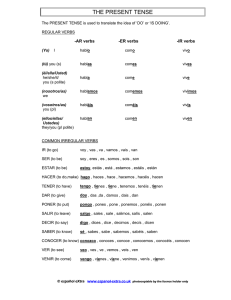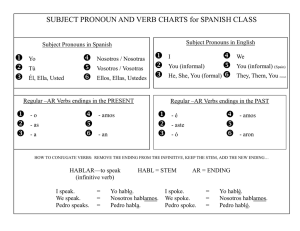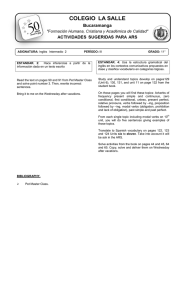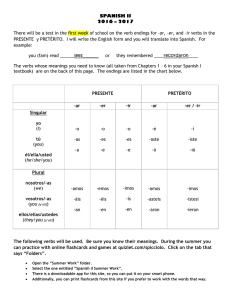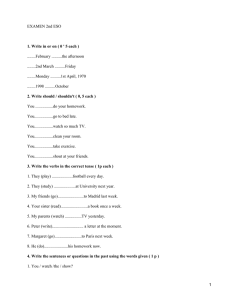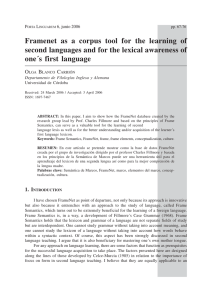SE INCOMPATIBLE PREDICATES IN SPANISH: AN RRG
Anuncio
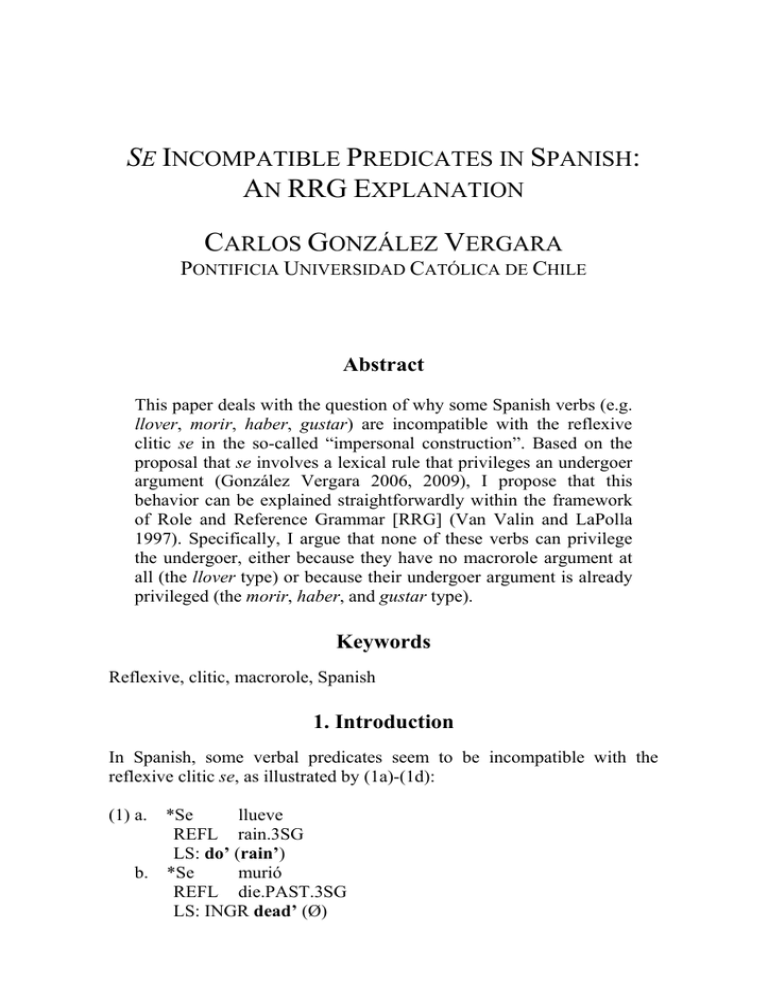
SE INCOMPATIBLE PREDICATES IN SPANISH: AN RRG EXPLANATION CARLOS GONZÁLEZ VERGARA PONTIFICIA UNIVERSIDAD CATÓLICA DE CHILE Abstract This paper deals with the question of why some Spanish verbs (e.g. llover, morir, haber, gustar) are incompatible with the reflexive clitic se in the so-called “impersonal construction”. Based on the proposal that se involves a lexical rule that privileges an undergoer argument (González Vergara 2006, 2009), I propose that this behavior can be explained straightforwardly within the framework of Role and Reference Grammar [RRG] (Van Valin and LaPolla 1997). Specifically, I argue that none of these verbs can privilege the undergoer, either because they have no macrorole argument at all (the llover type) or because their undergoer argument is already privileged (the morir, haber, and gustar type). Keywords Reflexive, clitic, macrorole, Spanish 1. Introduction In Spanish, some verbal predicates seem to be incompatible with the reflexive clitic se, as illustrated by (1a)-(1d): (1) a. *Se llueve REFL rain.3SG LS: do’ (rain’) b. *Se murió REFL die.PAST.3SG LS: INGR dead’ (Ø) c. *Se hay REFL there-is.3SG LS: be-in’ (cielo, nubes) d. *Se gusta REFL like.3SG LS: like’ (Ø, cine) nubes en clouds in el the cielo sky el cine the movies (1a), (1b), and (1c,d), respectively, involve activity, achievement, and state. The verb in (1a) selects no argument, the verb in (1b) selects one, while the verbs in (1c,d) select two. These examples prompt us to ask what these predicates have in common and why they are incompatible with se. These questions lead to another question of what the meaning/function of se is. I will propose below that these data can be explained in terms of the properties of the clitic se. 2. The Nature of Spanish se In Spanish, the clitic se appears as an essential component of a wide range of syntactic constructions. One of the most widely known classifications of the uses of se divides them into the following six subtypes (adapted from Hernández 1966): (2) a. b. c. d. e. Reflexive and reciprocal se mis amigos se golpearon. “My friends hit (themselves/each other).” Passive-reflexive se se construyeron muchas escuelas. “Many schools were built.” Impersonal-reflexive se se acusó a Pedro. “Pedro was accused.” “Interest se” Pedro se bebió una cerveza. “Pedro drank up a beer.” “Intrinsic se” 1. “Psychological” intrinsic-se Pedro se enojó. “Pedro got angry.” 2. “Physical” intrinsic-se with an animate/inanimate argument Pedro se levantó. “Pedro got up.” f. La puerta se cerró. “The door closed.” Middle se Esta puerta se cierra fácilmente. “This door closes easily.” In González Vergara (2006, 2009), I proposed that the uses of se illustrated by (2b,c,e,f) involve a lexical rule that modifies the logical structure of the sentence in such a way as to diminish the actor’s role and to privilege the undergoer when it is present (cf. Centineo 1995; Van Valin and LaPolla 1997; Bentley 2004) and makes the undergoer argument serve as the privileged syntactic argument [PSA]. Specifically, I propose the lexical rule in (3), which may apply to predicates of any Aktionsart type: (3) Given any kind of logical structure, make the argument x of the predicate unspecified. a. State: pred’ (x, y) ↔ pred’ (Ø, y) b. Activity: do’ (x, [pred’ (x, (y))]) ↔ do’ (Ø, [pred’ (Ø, (y))]) c. Active accomplishment: 1. do’ (x, [pred1’ (x, y)]) & BECOME pred2’ (y) ↔ do’ (Ø, [pred1’ (Ø, y)]) & BECOME pred2’ (y) 2. do’ (x, [pred’ (x)]) & BECOME be-LOC’ (y, x) ↔ do’ (Ø, [pred’ (Ø)]) & BECOME be-LOC’ (y, Ø) d. Accomplishment/achievement: BECOME/INGR pred’ (x, y) ↔ BECOME/INGR pred’ (Ø, y) e. Causative: 1. [do’ (x, Ø)] CAUSE [(BECOME/INGR) pred’ (y)] ↔ [do’ (Ø, Ø)] CAUSE [(BECOME/INGR) pred’ (y)] 2. [do’ (x, Ø)] CAUSE [do’ (y, [pred’ (y)])] ↔ [do’ (Ø, Ø)] CAUSE [do’ (y, [pred’ (y)])] Application of the lexical rule in (3) have a variety of consequences in (2a)-(2f), but they have in common that the actor argument that would otherwise be realized as the PSA is not available for the PSA selection after the application of the above lexical rule. As an illustration of how introduction of the reflexive clitic se changes a logical structure, let us consider the pair in (4): (4) a. Pedro ensució la Pedro stained.3SG the “Pedro stained the shirt.” camisa. shirt b. LS: [do’ (Pedro, Ø)] CAUSE [BECOME dirty’ (camisa)] LS: [do’ (Ø, Ø)] CAUSE [BECOME dirty’ (camisa)] (4a) is a transitive sentence without the clitic se and involves a causative logical structure, while (4b) is the result of the application of the lexical rule to (4a). An analogous logical structure is observed in “intrinsic se” sentences as in (5a), passive-reflexive sentences as in (5b), impersonal-reflexive sentences as in (5c) (in order to obtain this meaning, it is necessary to change the inanimate argument camisa “shirt” with a human argument Juan) and middle se sentences as in (5d): (5) a. b. c. d. [do’ (Ø, Ø)] CAUSE [BECOME dirty’ (camisa)] “Intrinsic se” La camisa se ensució. the shirt REFL stained.3SG “The shirt got dirty.” Passive-reflexive se Se ensució la camisa. REFL stained.3SG the shirt “The shirt was stained.” Impersonal-reflexive se Se ensució a Juan. REFL stained.3SG to Juan “Juan was stained.” Middle se La camisa se ensucia fácilmente. the shirt REFL stained.3SG easily “The shirt gets dirty easily.” 3. Some Apparent Exceptions Let’s now return to the set of verbs in (1), which I have argue cannot occur with se (e.g. llover “rain”, morir “die”, haber “have”, gustar “like”). An immediate problem that comes to mind is that some of these verbs turn out to be compatible with se, as illustrated by (6a)-(6c): (6) a. El techo se the roof REFL “The roof was rained.” llovió rain.PAST.3SG b. c. Pedro se murió Pedro REFL die.PAST.3SG “Pedro died.” María se gusta María REFL like.PRES.3SG “María likes herself.” It is important note that these verbs become compatible with se only when they involve the PSA. (6a,b) belong to the undergoer PSA construction, while (6c) is a reflexive construction. Nevertheless, these predicates cannot occur with se in the non-PSA (i.e. impersonal) construction. We are now in a position to refine our initial question and to ask why verbs as listed in (1) are not compatible with se in the non-PSA construction. (7a)-(7e) are an expanded set of those verbs: (7) a. b. c. d. e. llover “rain”, nevar “snow”, garúar “dizzle”, temblar “tremble” morir “die”, aparecer “appear”, crecer “grow”, envejecer “get old”, adelgazar “slim” hay “there is” alcanzar “have enough”, apenar “cause sorrow”, convenir “suit”, costar “take effort”, doler “feel hurt”, extrañar “feel the lack”, faltar “lack”, gustar “like”, importar “matter”, interesar “be interested”, molestar “be bothered”, preocupar “be worried”, quedar “have left”, sobrar “spare” dar pena/miedo/gusto “feel pity/fear/delight” 4. Proposal If se is the morphological expression of the lexical rule that privileges the undergoer argument, we can explain why se is not compatible with the predicates in (7). The reason is that their logical structures cannot privilege an undergoer argument, either because the undergoer is already the privileged argument or because their logical structures don’t have any argument in the first place. I propose four subtypes of se incompatible verbs: the llover type, morir type, haber type, and gustar type. Let’s examine all of these types below. 4.1. The llover type Verbs as llover “rain”, nevar “snow”, and temblar “tremble (the earth)”, usually known as “weather verbs”, involve an activity predicate do’ with no argument in its logical structure, as illustrated in (8): (8) Ayer llovió/nevó /tembló yesterday rain.PAST/snow.PAST/tremble.PAST “Yesterday, it rained/snowed/trembled.” LS: yesterday’ (do’ (rain’/snow’/tremble’)) The consequence of having no argument is that these verbs have no undergoer argument. If there is no undergoer argument available, there is no way to privilege it. Therefore, these verbs are not compatible with se. It has to be noted again that apparent exceptions such as (9) are not really “weather verbs” as defined above, but predicates that have at least one semantic argument that is able to function as the PSA, as demonstrated by the agreement marker on the verb: (9) a. b. Las carpas se llovieron the tents REFL rain.PAST.3PL “The tents were soaked in rain.” Los patios se nevaron the backyards REFL snow.PAST.3PL “The backyards got covered in snow.” 4.2. The morir type Verbs as morir “die”, aparecer “appear”, crecer “grow”, envejecer “get old”, and adelgazar “slim” are accomplishment or achievement verbs that have a state predicate with one argument in their logical structures. Since the base predicate is a state, the only arguments of these verbs are undergoers in accordance with the default macrorole assignment principles (Van Valin and LaPolla 1997). These verbs have no choice but to choose the undergoer arguments as their PSAs. This explains why these verbs cannot co-occur with se, because the undergoer already serves as the PSA: (10) a. *Se murió. LS: INGR dead’ (Ø) b. *Se creció. LS: PROC grown’ (Ø) c. *Se envejeció. LS: PROC old’ (Ø) d. *Se adelgazó LS: PROC thin’ (Ø) It is worthy of notice that the morir type verbs cannot occur with se when they are part of the non-PSA construction, but that they can do so when they are part of the PSA construction as in (11) (see González Vergara 2006 for further discussion): (11) a. Tus mascotas se murieron your pets REFL die.PAST.3PL “Your pets died.” b. El equipo se creció the team REFL grow.PAST.3SG “The team grew stronger.” c. La actriz se envejeció The actress REFL get.old.PAST.3SG “The actress got old.” d. El niño se adelgazó The boy REFL slim.PAST.3SG “The boy slimmed.” 4.3. The haber type Haber “have” is a two-place state predicate one of whose arguments is a locative (Fernández Soriano and Táboas 1999). However, the locative argument fails to receive an actor status and is realized by a prepositional phrase. In contrast, the second argument of haber “have” (theme) serves as the PSA. In order to accommodate this linking, it is necessary to stipulate the number of macroroles as in (12). (12) Hay nubes en be.PRES.3SG clouds in “There are clouds in the sky.” LS: be-in’ (sky, clouds) [MR1] el the cielo sky Given that haber “have” involves only one macrorole (undergoer) because of [MR1], the undergoer argument serves as the PSA. Once again, we can see that haber “have” is not compatible with se, because the undergoer is already privileged as the PSA. 4.4. The gustar type Verbs such as gustar “like”, faltar “lack”, importer “matter” and sobrar “spare” exhibit an unexpected syntactic behavior. Gustar, for instance, is semantically similar to the English verb like, but their syntactic behaviors are different. (13) a. I like apples. b. (A mí) me (to me) 1SG.DAT “I like the apples.” gustan like.PRES.3PL las the manzanas apples My proposal is that unlike the English verb like, gustar receives only one macrorole ([MR1]). Since gustar “like” is a state predicate, the only macrorole should be an undergoer. The actor-undergoer hierarchy requires us to choose the second argument as the undergoer. The first argument of the state predicate has no choice but to become a non-macrorole, which is optionally realized by a PP. The gustar type is not compatible with the clitic se, because it already privileges the undergoer argument as the PSA. 5. Summary As we have seen, all of those verbs that are incompatible with se in the non-PSA construction have one thing in common: they cannot privilege the undergoer argument, either because they have no macrorole argument (the llover type) or because their undergoer argument is already privileged (the morir, haber and gustar type). The above data and discussion support the proposal that Spanish se involves the lexical rule that modifies the logical structure of the predicate by diminishing the actor’s role and privileging the undergoer’s when it is present (González Vergara 2006, 2009).1 1 Verbs of the morir type sometimes co-occur with se in the non-PSA construction when they are in the imperfective aspect: Se muere/moría bien cuando se muere/moría REFL die.PRES/IMPERF well when REFL die.PRES/IMPERF por un ideal. for an ideal “One dies/used to die well when one dies/used to die for an ideal.” We can also see that the meaning of the above example is similar to that of an attributive sentence (e.g. La muerte puede ser buena cuando es por un ideal “Dying can be good when it happens for an ideal”) (see Felíu Arquiola 2008 and González Vergara 2006, 2009 for related discussion). This and analogous examples remain as a genuine counterexample to the generalization put forward in this paper. List of Abbreviations DAT PAST PL dative past tense plural PRES REFL SG present tense reflexive singular References Bentley, Delia. 2004. Unexpressed arguments: si-constructions in Italian. In Brian Nolan, ed., RRG2004 Book of Proceedings: Linguistic Theory and Practice: Description, Implementation and Processing, 17-48. Dublin: Institute of Technology Blanchardstown. Centineo, Giulia. 1995. The distribution of si in Italian transitive/inchoative pairs. Proceedings of Semantics and Linguistic Theory 5: 54-71. Hernández, César. 1966. Del se reflexivo al impersonal. Archivum 16: 3966. Felíu Arquiola, Elena. 2008. Spanish middle sentences: a Role and Reference Grammar approach. In Rolf Kailuweit, Bjorn Wiemer, Eva Staudinger, and Ranko Matasović, eds., New Applications of Role and Reference Grammar: Diachrony, Grammaticalization, Romance Languages, 356-388. New Castle: Cambridge Scholars Publishing. Fernández Soriano, Olga and Susana Táboas. 1999. Construcciones impersonales no reflejas. In Ignacio Bosque and Violeta Demonte, eds., Gramática descriptiva de la lengua española, 1723-1778. Madrid: Espasa. González Vergara, Carlos. 2006. Las construcciones no reflexivas con se: una propuesta desde la Gramática del Papel y la Referencia. Unpublished Ph.D. dissertation, Universidad Complutense de Madrid. González Vergara, Carlos. 2009. One rule to rule them all: logical structures for Spanish non-reflexive se sentences. In Lilián Guerrero, Sergio Ibáñez, and Valeria Belloro, eds., Studies in Role and Reference Grammar, 361-379. México: UNAM. Van Valin, Robert D., Jr. and Randy J. LaPolla. 1997. Syntax: Structure, Meaning and Function. Cambridge: Cambridge University Press.
